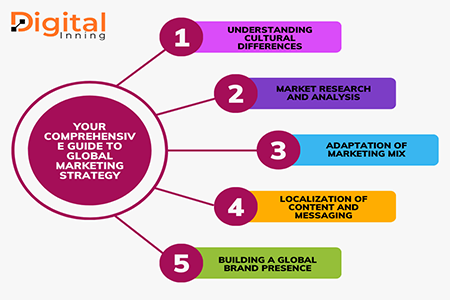How to Build a Well-Planned Global Marketing Strategy in 4 Steps

What is Global Marketing?
Put simply, global marketing refers to smoothly transitioning your business from a regional presence to a global one, ensuring a unified brand message across the world.
Dissimilar to international marketing, which involves marketing the products/services in any specific foreign country by adapting messaging as per the local market, global marketing utilizes the same marketing approach in every country. However, there may be some modifications in the messaging as per the local traditions, languages, and cultural preferences.
Let us take the example of McDonald's for a better idea. When McDonald's entered the Indian market, they introduced a range of vegetarian products that are not available in any other countries. The reason was the majority of the population in India is vegetarian. For non-veg products, since it is illegal to eat beef in India, McDonald's has introduced Chicken Maharaja Mac as a substitute for the Big Mac (which includes beef).
Therefore, McDonald's had to adapt to the local tastes, cultural preferences, and dietary restrictions of Indian consumers.
Steps to Build a Global Marketing Strategy
To create an effective global marketing strategy, businesses have to understand their customers and the business landscape in different foreign countries and their cultures. Here are the important steps to follow for a robust plan:
1. Conducting Detailed Research
Just as it requires opening a new business, thorough research is essential for global marketing as well. When expanding globally, you should study their culture and behavior. It helps tailor the strategy that caters to varying customer's expectations and customs. Take time to choose regions where you have significant business opportunities.
In the end, it is about your customer's preferences and expectations. People in some regions may prefer to buy products/services from physical stores. While in other regions, most of them choose to buy online. In this case, your business should have a proper digital presence available to them. Through these, they can conveniently get access to your products/services. If you do not have a grip on digital marketing, opting for a digital marketing company in Rajkot could be your helping hand. You can avail of our services and enjoy the benefits of successfully presenting your business digitally to your target audience in the global market.
By conducting thorough marketing research, you can easily avoid making costly mistakes that may negatively impact the overall revenue and growth of
the business.
2. Assemble Your Marketing Team
It is always a better step to make sure that you have some experienced and expert team members who live or work in your target areas. Hiring local freelancers or a marketing agency could be also a better option within your expense limits. You can follow up with a proper analysis of your budget and decide which option could fit well. Allow your team to connect through digital workspace. Allow them the access to necessary data so they can access it and engage with other team members for marketing operations.
The detailed research will help you find the regions which suit best for your product/services and the business. Now it is time to take a step ahead and assemble the talented team for the execution of the marketing strategy.
It is a must to have experienced members in your team working or located somewhere around the targeted region. You can also choose to team up with the digital marketing agency in Rajkot and get the best possible output from your online presence, enabling more business for you.
3. Create a Localized Marketing Plan
Start with identifying your business' vision and check how it aligns with the potential market. Believing that pain points and characteristics are the same in every market could be a big mistake.
Giving a local feel to your products/services can help make the local customers put trust in your business. When planning for advertisements either online or through offline mediums, it is crucial to connect with the target audience. Get familiarized with their requirements and culture, and tailor the brand messaging based on that information. The 4 P's of your global marketing may require adjustments for local markets in varying regions. Learn about popular cultural events and holidays to give the upper hand to your marketing strategy.
The value proposition of your product/services may vary depending on the particular market. Therefore, it is critical to adapt accordingly. Through this, a sense of reliability can be easily created, and you may have to face fewer challenges during global marketing.
4. Tweak and Improve
Whether it is local or global marketing, both require adaptive continuous changes (tweaking). Use the latest information and feedback to get ideas to keep on improving your product/services. This approach helps identify common mistakes made without your information and make necessary adjustments to solve them. When you navigate mistakes and challenges come in the way, it becomes easier to improve your operations and stay competitive in the global market, especially when you are new to a market which already has established competitors.
Let's resolve your queries once and for all. Explore FAQ's
Seo Company in Rajkot
